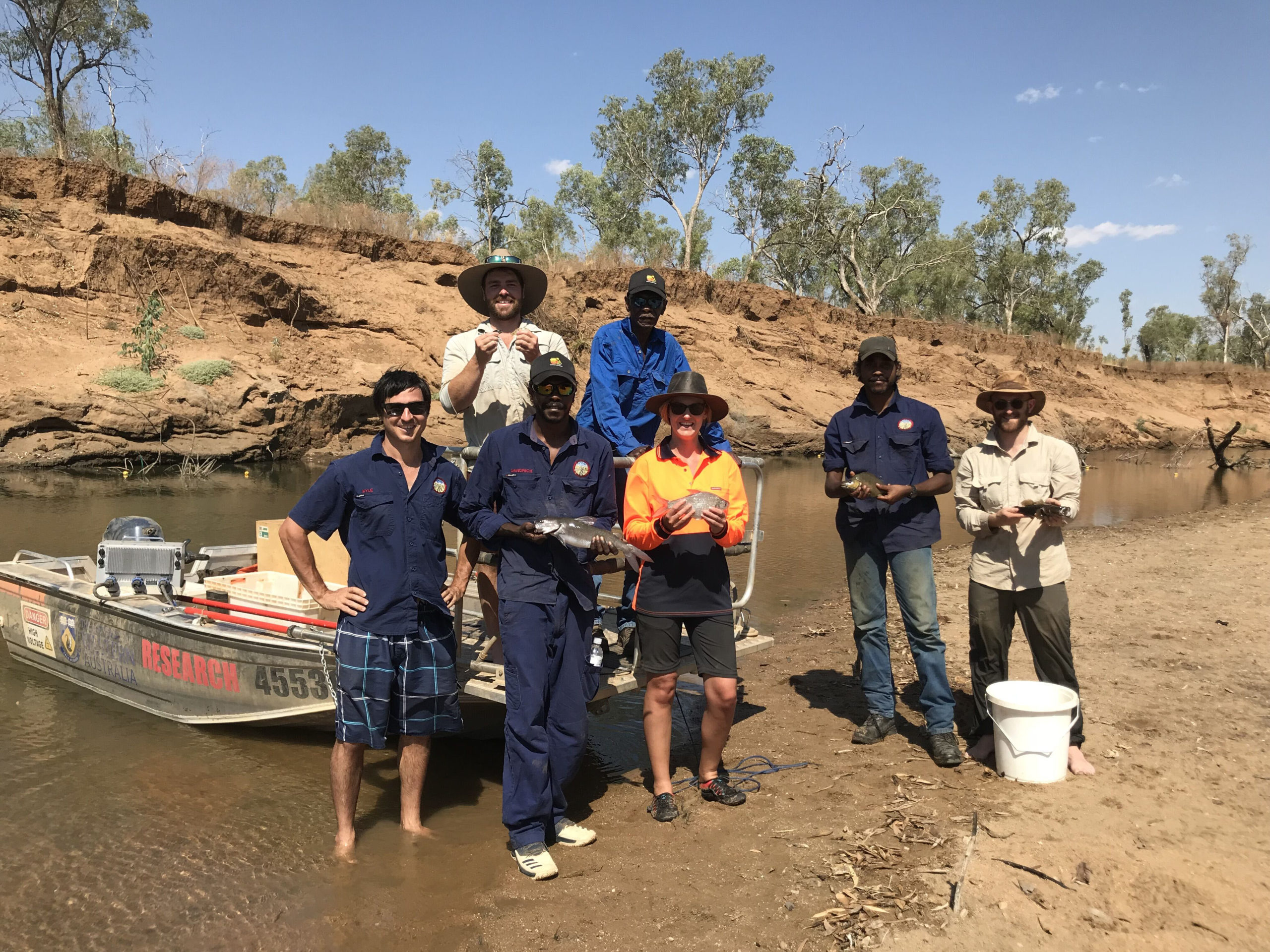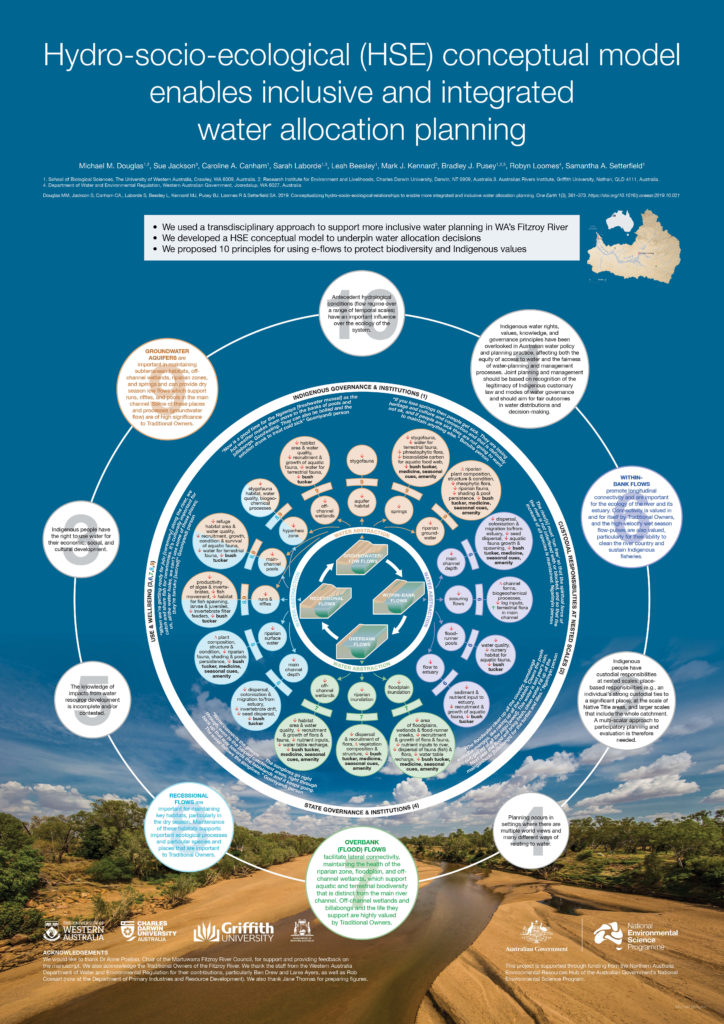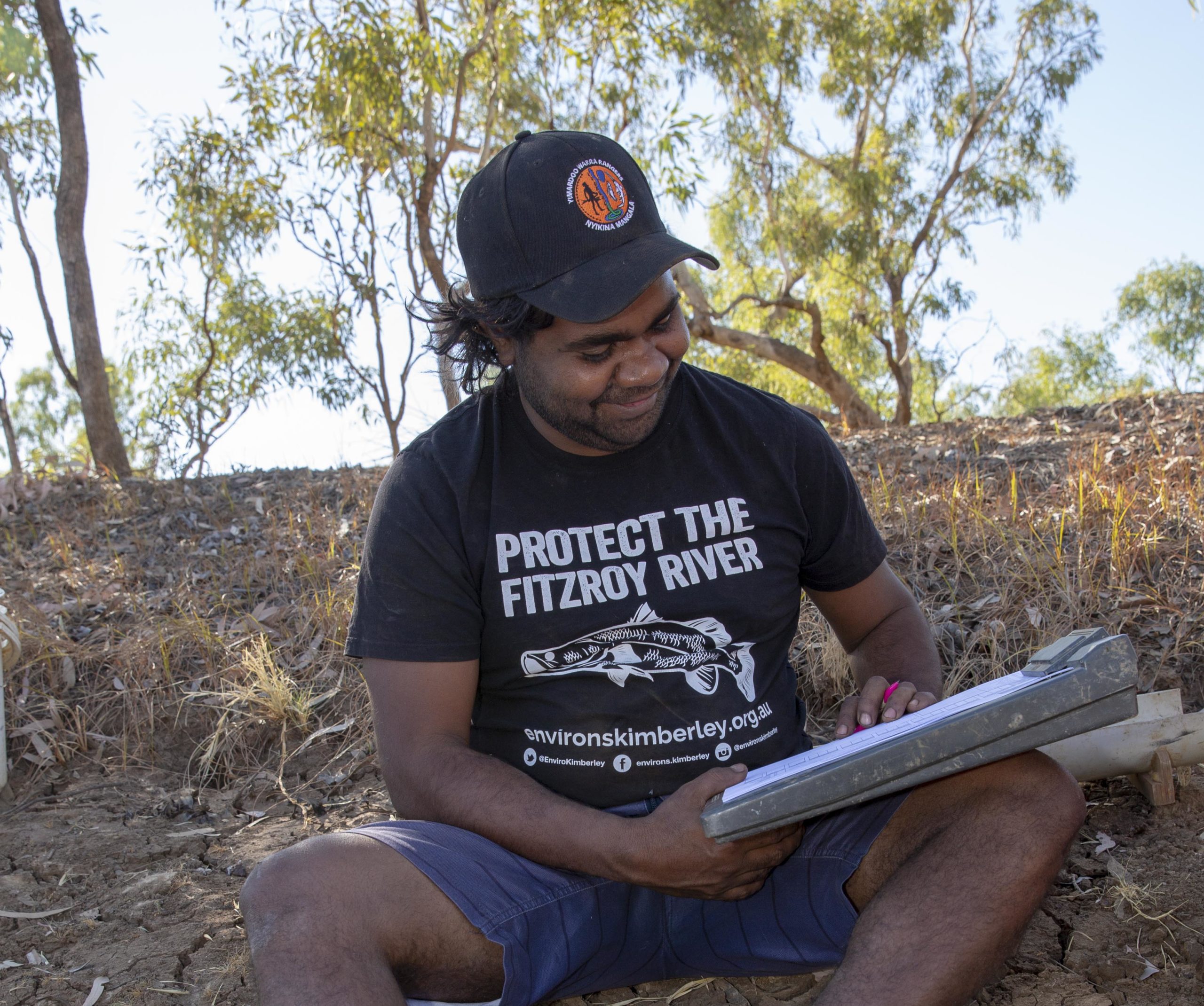The mighty National Heritage-listed Fitzroy River in the west Kimberley has the largest flow of any river in Western Australia. With increasing interest in irrigated agriculture in the region, research by the NESP Northern Hub is increasing knowledge of the important environmental and cultural water requirements of the river, working in partnership with the Fitzroy River Traditional Owners.
The Fitzroy is one of Australia’s great rivers. From its headwaters in the central Kimberley, it flows over 730 km west to King Sound, fed by 20 tributary rivers that drain a catchment area of almost 95,000 square kilometres. Eighty percent of the people living within the Fitzroy’s catchment are Indigenous, comprising seven ethno-linguistic groups across seven native title determinations that encompass almost the entire catchment.
The west Kimberley region is on the National Heritage list for its rich natural and cultural values, including those of the Fitzroy.
The Fitzroy River and a number of its tributaries, together with their floodplains and the jila sites of Kurrpurrngu, Mangunampi, Paliyarra and Kurungal, demonstrate four distinct expressions of the Rainbow Serpent tradition associated with Indigenous interpretations of the different ways in which water flows within the catchment and are of outstanding heritage value to the nation … for their exceptional ability to convey the diversity of the Rainbow Serpent tradition within a single freshwater hydrological system.
– Commonwealth of Australia 2011
Like all rivers, it is a dynamic system. After heavy monsoonal rains, the lower reaches of the Fitzroy become a 300-kilometre-long floodplain that can be up to 15 kilometres wide. These floods recharge groundwater, replenish riparian vegetation and fill wetlands and billabongs away from the main channel.
Some pastoralists in the region are increasingly interested in developing irrigated agriculture and the Commonwealth and Western Australian governments have funded reports exploring the potential of the region for water development. The 2016 Fitzroy River Declaration expressed the concerns of the Traditional Owners about the potential impacts of water extraction on the river’s cultural and environmental values, and their desire that a catchment management plan include their aspirations for the region and provide a means of involving them in decisions over water.

Gooniyandi Rangers working with the NESP Fitzroy River fish team. Photo by Leah Beesley.
In March 2019, Western Australian Minister for Water Dave Kelly stated that the water allocation plan for the catchment, which informs the management plan, would be based upon scientific evidence and protect cultural and environmental values.
The Australian Government’s National Environmental Science Program’s Northern Hub has made a significant contribution to this process, bringing together research on the relationship that the Traditional Owners have with the Fitzroy and undertaking new research on the habitat and food requirements of fish and the environmental water needs of riparian vegetation.
The first step in transdisciplinary research led by Professor Michael Douglas from The University of Western Australia and Professor Sue Jackson of Griffith University was to build a model of hydrological connectivity that helped water planners ensure that every aspect of the river’s flow regime and their importance to Traditional Owners were addressed. This led to the formulation of a set of principles to guide water planning that encompasses both the cultural values of the Traditional Owners and the water needs of river ecosystems as the Fitzroy’s flows fluctuate from wet to dry.
It’s our active process of governance and management of the water resources that Indigenous people are interested in having recognised, rather than just how much water we need.
– Dr Anne Poelina, Nyikina Traditional Custodian and chair of the Martuwarra Fitzroy River Council
Each principle is supported by a number of key considerations, many of which the WA Department of Water and Environmental Regulation (DWER) has used to guide the water allocation plan.
 This poster was produced to highlight the conceptual model developed around the 10 principles for using e-flows to protect aquatic ecosystems and their dependent human cultures and livelihoods.
This poster was produced to highlight the conceptual model developed around the 10 principles for using e-flows to protect aquatic ecosystems and their dependent human cultures and livelihoods.
“It’s a peer reviewed, scientific approach,” says Robyn Loomes, environmental officer with DWER, who was directly involved in the research that has now been published in the journal One Earth (and is freely available online).
We’ve used the environmental principles to frame our approaches and to really focus on the key components of the water regime. Each principle has a detailed set of considerations and we’ve made sure we’ve addressed those.
– Mrs Robyn Loomes
Mrs Loomes says that a strength of the Northern Hub is their ability to manage complex research projects while still being flexible enough to adapt to emerging questions.
The science has been tailored to answer our questions directly in relation to our water requirement and water planning needs.
– Robyn Loomes
The Northern Hub’s ‘shared learning’ approach to research and its strong relationship with Traditional Owners in the Fitzroy River catchment has helped DWER to better understand the river and the relationships that people have with it.

Yimardoo-Warra Ranger Jeremiah Green collecting data on the Fitzroy River to help inform water planning. Photo by Michael Douglas.
Mrs Loomes explains that while DWER has a long history of working with Traditional Owners in the Fitzroy, most of these meeting have taken place in towns or communities.
Working with the Northern Hub and being in the field means that I’ve gotten to be out on country with people and actually see and experience places that they value and to share their stories. The Hub’s work with the Traditional Owners has provided an amazing insight into the complexities and nuances of working in the Fitzroy. And that is an incredible strength.
– Robyn Loomes
The next steps in this transdisciplinary project involve moving beyond the literature to draw in results from field research to ensure that final recommendations more precisely reflect Indigenous ways of understanding the river and their relations with it, as well as deeper ecological knowledge obtained through fieldwork.
Reference
Research outputs
Scientific papers
Factsheets
Project webpages
Attributions